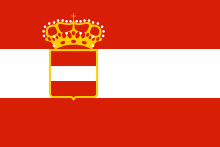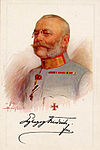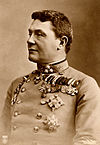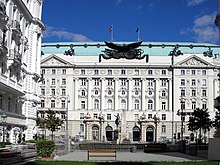Armed Forces of Austria-Hungary
|
|||
 Coat of arms of the Austro-Hungarian monarchy |
|||
| guide | |||
|---|---|---|---|
| Commander in Chief : |
Commander in Chief :
Franz Joseph I (1848-1914)
|
||
| Defense Minister: |
Austro-Hungarian War Minister (from 1912 ):
Moritz von Auffenberg |
||
| Military Commander: |
Chief of Staff :
Friedrich von Beck-Rzikowsky ( 1881-1906 )
|
||
| Military leadership: | His Majesty's Military Chancellery, Army High Command (in case of war), General Staff | ||
| Military strength | |||
| Active soldiers: | 450,000 men plus 18,000 navy men (July 1914) |
||
| Conscription: | Yes, with the Defense Act of December 5, 1868 | ||
| Eligibility for military service: | 19 to 42 years from 1915 18 to 50 years |
||
| household | |||
| Military budget: | 670 million crowns (1912) | ||
| Share of gross domestic product : | 3.5% (1912) | ||
| history | |||
| Founding: | March 5, 1867 | ||
The Armed Forces of Austria-Hungary (officially known as the Armed Power or Wehrmacht ) were the military of the Austro-Hungarian Dual Monarchy . With the land forces and the navy, they consisted of two (at the end of the war in 1918 not formally, but in fact with the aviation force of three) branches . The land forces consisted of three branches of service, each with its own administration: the Common Army , the Imperial and Royal Landwehr and the Imperial and Royal Landwehr .
The commander-in-chief was the emperor of Austria , military commander the chief of staff and head of the supreme administrative body of the kuk war minister . In view of the outbreak of World War I , Emperor Franz Joseph I also set up an army command .
history
prehistory
The Austrian Empire , founded in 1804, was an undivided rulership and a monarchical unitary state of the House of Habsburg-Lothringen . The Imperial and Royal Army under the command of the Kaiser was the institution of a unitary state, which, however, was interwoven as a member state in the German Confederation . In the revolutionary year of 1848, the Imperial and Royal Army was only able to hold out against Hungary thanks to massive Russian military aid and the use of the Croats under Banus Jellačić . In 1859, after the Battle of Solferino and Magenta, Lombardy was lost to the newly founded Kingdom of Italy . Because of the reform question and the dispute over Schleswig-Holstein , the situation towards Prussia ( German question ) escalated in 1866 . On June 14, 1866, Austria applied to the Bundestag to mobilize the army against Prussia. This started the German war . In the Battle of Königgrätz in Bohemia in 1866, Austria was decisively defeated by Prussia. In the Peace of Prague , Austria accepted the dissolution of the German Confederation and that Prussia could reorganize the situation in Germany. Inside, the empire had to be put on a new basis. The most viable option seemed to Emperor Franz Joseph I to come to an agreement with the moderate Hungarian liberals under Count Andrássy and Ferenc Deák and to offer the Kingdom of Hungary a special status.
Foundation and the years up to 1914
The Armed Force was established on March 5, 1867 after the Austro-Hungarian Compromise . The army and navy were no longer institutions of a unitary state, but of the new dual monarchy, which consisted of two equal parts: the Austrian Empire ( Cisleithanien ) and the Kingdom of Hungary ( Transleithanien ), which was no longer subordinate to this, but joined in Real Union . The land forces of Austria-Hungary were formed by the joint army together with the kk Landwehr and the ku Honvéd (Hungarian Landwehr) . With the Austro-Hungarian Navy they formed the armed forces of Austria-Hungary. Until 1889, the armed forces carried the predicate kk, as they did before 1867 ( imperial-royal , since 1867 actually misleading for a common institution of both halves of the empire). It was only at the express request of Hungary that the law of April 11, 1889 introduced the term kuk for the army. The land forces experienced only one emergency from 1867 to 1914: the campaign in Bosnia and Herzegovina after the occupation approved by the Berlin Congress in 1878 . The mission came about because armed resistance had to be overcome. In 1908 parts of the Joint Army were mobilized to suppress the uprising in Bosnia-Herzegovina.
First World War
In view of the outbreak of World War I , Emperor Franz Joseph I set up an army high command under Archduke Friedrich von Österreich-Teschen as high commander and Franz Conrad von Hötzendorf as chief of staff. The armed power, together with the German army, represented the main armed forces of the Central Powers in World War I , which were the military adversaries of the Entente . The armed forces of Austria-Hungary were partly dependent on the support of the German Army, especially after the Brusilov offensive for them . Italy's entry into the war in 1915 also presented the armed forces of Austria-Hungary with difficult tasks. The last battle of the First World War was the Battle of Vittorio Veneto or Third Piave Battle from October 24, 1918 to November 3 or 4, 1918 , which ended with the defeat of Austria-Hungary. Depending on your point of view, the armed forces of Austria-Hungary existed until the collapse of the dual monarchy (Hungarian troops left on October 31, 1918) and the end of the First World War (November 11, 1918).
Armed forces
Land Forces
As a novelty in military history, since the so-called Compensation of 1867, the army consisted of three troop bodies, each with its own administration, existing side by side.
- The Joint Army with:
- 108 infantry regiments
- 33 hunter battalions
- 98 artillery regiments
- 10 independent artillery battalions
- 42 cavalry regiments
- kuk Voluntary Motor Corps
- kuk aviation troops
- Train, pioneer, bridge building, railroad, telegraph, motor vehicle departments and the Danube flotilla
- The kk Landwehr with:
- 35 infantry regiments
- 6 mountain infantry regiments
- 2 mounted rifle divisions (battalions)
- 6 cavalry regiments
- 18 artillery divisions (battalions)
- The ku Landwehr with:
- 32 infantry regiments
- 10 cavalry regiments
- 8 artillery regiments
- 1 mounted artillery division (battalion)
- The Croatian-Slavonian Landwehr was integrated into the ku Landwehr .
Navy
The imperial and royal navy , known as kk until 1889 , then kuk , comprised the naval section of the war ministry in Vienna , the subordinate naval command in Pola , the navy's largest naval port and base , and other offices at home and abroad.
Political and military leadership
Commander in chief
The Commander-in-Chief of the Armed Power was normally the Emperor of Austria and the Apostolic King of Hungary as Supreme Commander-in-Chief . If the office of the emperor was vacant or the emperor did not want the supreme command (for whatever reason), an army commander in chief stepped in as the commander in chief.
List of incumbents
| image | Title and name | Service position | Remarks) |
|---|---|---|---|
|
Emperor Franz Joseph I (1830-1916) |
Supreme Commander in Chief (1848-1914) | Established the army high command in case of war and in 1914, because of his old age, handed over the high command to Archduke Friedrich | |
|
Archduke Friedrich of Austria-Teschen (1856–1936) |
Army Commander in Chief (1914-1916) | ||
|
Emperor Karl I (1887–1922) |
Supreme Commander in Chief (1916-1918) | Took supreme command from Archduke Friedrich in 1916. Appointed Hermann Kövess as the new commander in chief on November 3, 1918 at the request of General Arthur Arz . Demobilized the army on November 6th and on October 31st gave the navy to the South Slav state. | |
|
Hermann Albin Kövess (1854–1924) |
Army Commander in Chief (from 1918) | Lost command of the Hungarian armed forces on October 31, 1918 (collapse of the dual monarchy). Disbanded the army by December 3, 1918 and resigned from command on December 19, 1918. |
Chief of Staff
The Chief of Staff was the military commander of the Armed Power.
List of incumbents
| image | Rank and name | Time in office | Remarks) |
|---|---|---|---|
|
Feldzeugmeister Friedrich von Beck-Rzikowsky (1830–1920) |
1881-1906 | In office for 25 years. Was a close confidante of Emperor Franz Joseph I. Under his leadership, the General Staff de facto became the supreme command of the armed forces. | |
|
Field Marshal Franz Conrad von Hötzendorf (1852–1925) |
1906–1911 and 1912– March 1, 1917 | Became Chief of Staff on November 18, 1906 at the suggestion of Archduke Franz Ferdinand. | |
|
General Arthur Arz von Straussenburg (1857-1935) |
March 1, 1917 - November 2, 1918 | Declared that after the US joined the Entente, the military had no chance of victory. Advised Emperor Karl to an armistice. Recommended to make the emperor Hermann Kövess the new commander in chief. |
Army High Command
The Army High Command was established on July 31, 1914 by Emperor Franz Joseph I , with a view to the First World War. It was directed by the emperor or the army commander. After its establishment in 1914, the Army High Command was the command center for the entire armed power. It existed until the fall of the dual monarchy in autumn 1918.
kuk war ministry
From 1867 to 1918, the Austro-Hungarian War Ministry was the highest administrative authority of the Joint Army and the Austro-Hungarian Navy.
The Ministry was managed under the umbrella term Central Management and Military Authorities. At the head was the Austro-Hungarian War Minister who was subordinate to the commander in chief and who was appointed and removed by the monarch.
ku and kk ministries
For the "Royal Hungarian Landwehr" that was ku Honvédministerium and for the "Imperial Royal Landwehr" the kk Ministry of Defense in charge. Both troops were therefore not subordinate to the Austro-Hungarian War Ministry.
See also
literature
- Johann Christoph Allmayer-Beck : The armed power in the state and society. In: Adam Wandruszka, Peter Urbanitsch (Ed.): The armed power. (= The Habsburg Monarchy (1848–1918). 5). Vienna 1987, ISBN 3-7001-1122-3 , pp. 1–141.
- Johann Christoph Allmayer-Beck, Erich Lessing: The Kuk Army. 1848-1914 . Bertelsmann publishing house, Munich 1974, ISBN 3-570-07287-8 .
- Oskar Brüch , Günter Dirrheimer: Writings of the Army History Museum in Vienna. Volume 10: The kuk Heer 1895. Military Science Institute, Stocker Verlag, Graz 1997, ISBN 3-7020-0783-0 .
- Laurence Cole, Christa Hämmerle, Martin Scheutz (eds.): Shine - violence - obedience. Military and Society in the Habsburg Monarchy (1800 to 1918). Klartext, Essen 2011, ISBN 978-3-8375-0409-5 .
- Peter Fichtenbauer , Christian Ortner : The history of the Austrian army from Maria Theresa to the present in essays and pictorial representations , Verlag Militaria, Vienna 2015, ISBN 978-3-902526-71-7
- Christa Hämmerle: The k. (u.) k. Army as a 'school of the people'? On the history of general conscription in the multinational Habsburg monarchy (1866–1914/18). In: Christian Jansen (Ed.): The citizen as a soldier. The Militarization of European Societies in the Long 19th Century: An International Comparison. Essen 2004, pp. 175-213.
- Lothar Höbelt : The Navy . In: Adam Wandruszka, Peter Urbanitsch (Ed.): The armed power. (= The Habsburg Monarchy (1848–1918). 5). Vienna 1987, ISBN 3-7001-1122-3 , pp. 687-763.
- Austro-Hungarian War Ministry: Dislocation and division of the Austro-Hungarian Army, the Austro-Hungarian Navy, the Imperial and Royal Landwehr and the Imperial and Royal Landwehr. In: Seidel's small army scheme. Seidel & Sohn, Vienna 1914.
- Austro-Hungarian War Ministry: Adjustment regulation for the Austro-Hungarian Army, the Imperial and Royal Landwehr, the Imperial and Royal Landwehr, the affiliated institutions and the corps of military officials. Vienna 1911/1912.
- Julius Lohmeyer: The military picture book - The armies of Europe. Carl Flemming Verlag, Glogau o. J.
- Peter Melichar , Alexander Mejstrik: The armed power. In: Helmut Rumpler, Peter Urbanitsch (ed.): The Habsburg Monarchy 1848–1918. Volume IX: Social Structures. Part 1, Volume 2, Verlag der Österreichische Akademie der Wissenschaften, Vienna 2010, pp. 1263–1326.
- Austrian Federal Ministry for the Army (Ed.): Austria-Hungary's Last War 1914-1918 Vol. 1 The war year 1914 . Publishing house of the military science reports, Vienna 1931.
- Manfried Rauchsteiner : The death of the double-headed eagle: Austria-Hungary and the First World War. 2nd Edition. Verlag Styria, Graz 1994, ISBN 3-222-12116-8 .
- Stefan Rest, M. Christian Ortner , Thomas Ilming: The emperor's rock in the First World War - uniforms and equipment of the Austro-Hungarian army from 1914 to 1918. Verlag Militaria, Vienna 2002, ISBN 3-9501642-0-0 .
- Hugo Schmid: Army: teaching and learning aids for military educational institutions and reserve officer schools. Volume 2 Austria-Hungary . Self-published by Hugo Schmid, Vienna 1916.
- Peter Urbanitsch, Helmut Rumpler (ed.): The Habsburg Monarchy 1848–1918 / Constitution and Parliamentarism: Constitutional law, constitutional reality, central representative bodies. Volume VII, Publishing House of the Austrian Academy of Sciences, Vienna 2000, ISBN 3-7001-2869-X .
- Adam Wandruszka (Ed.): The Habsburg Monarchy 1848–1918 / The armed power. Volume V, Publishing House of the Austrian Academy of Sciences, Vienna 1987, ISBN 3-7001-1122-3 .
- Alphons Frhr. v. Wrede: History of the KuK Wehrmacht from 1618 to the end of the XIX century Vienna, 1898–1905.
Web links
- Homepage about the Austro-Hungarian Army
- Another German-language website about the Austro-Hungarian Army
- Austria's Volunteer Corps in 1859 Vienna, 1860, e-book of the Vienna University Library ( e-books on demand )
- The history of the military of the KK Austrian monarchy from all branches of arms , 1850, e-book of the University Library Vienna ( e-books on demand )
Individual evidence
- ↑ Austrian Federal Ministry for the Army (Ed.): Austria-Hungary's Last War 1914-1918 Vol. 1 The War Year 1914 P. 80
- ↑ Lothar Höbelt: The Navy, p. 742
- ↑ (Reichsgesetzblatt p. 437)
- ^ Hugo Schmid: Army: teaching and learning aids for military educational institutions and reserve officer schools. Volume 2 Austria-Hungary p. 4
- ↑ (Reichsgesetzblatt p. 179)











